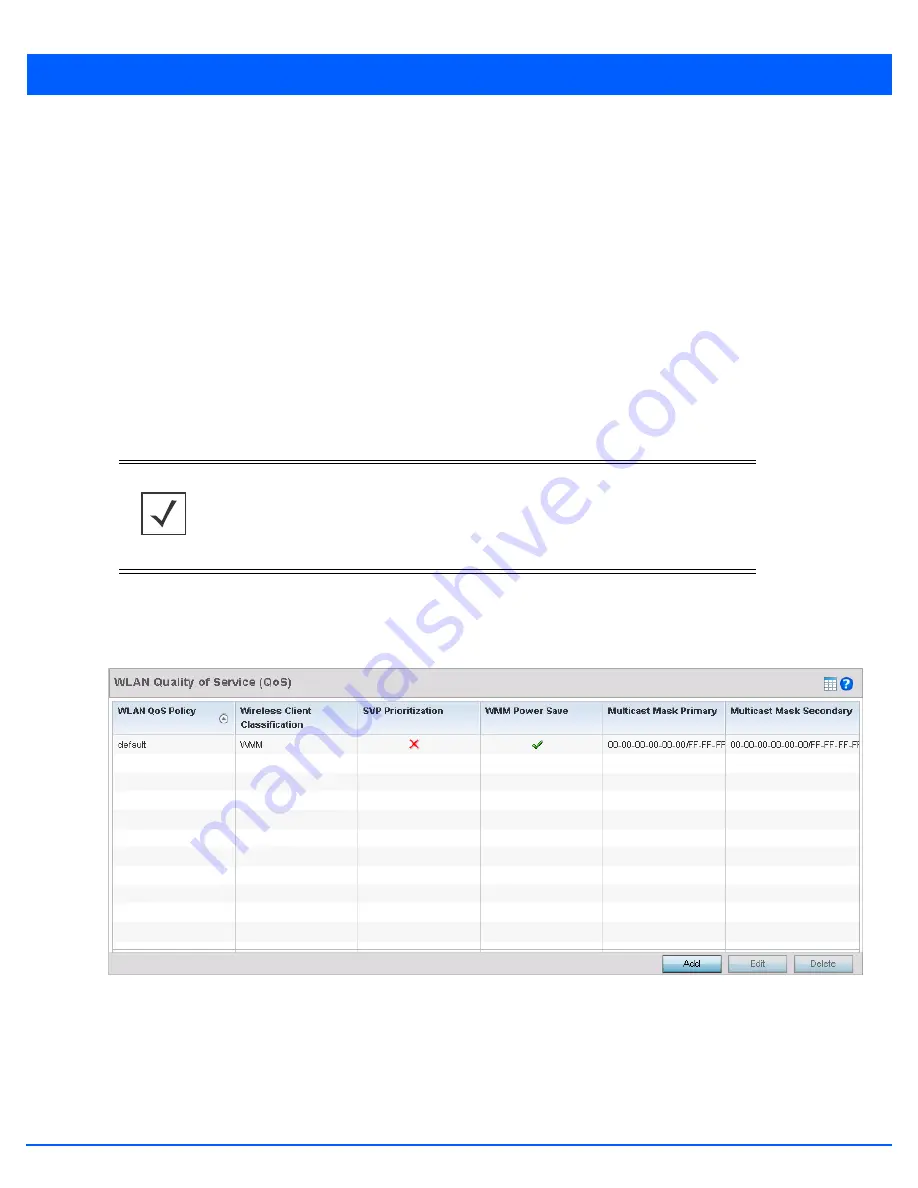
6 - 54 WiNG 5.7.1 Access Point System Reference Guide
6.3 WLAN QoS Policy
QoS provides a data traffic prioritization scheme that reduces congestion from excessive traffic. If there is enough bandwidth
for all users and applications (unlikely because excessive bandwidth comes at a very high cost), then applying QoS has very
little value. When bandwidth is shared by different users and applications, QoS provides policy enforcement for mission-critical
applications and/or users with critical bandwidth requirements.
QoS ensures each WLAN receives a fair share of the overall bandwidth, either equally or in the configured proportion. Packets
directed towards clients are classified into categories such as
Video
,
Voice
and
Data
. Packets within each category are
processed based on the weights defined for each WLAN.
The
Quality of Service
screen displays a list of QoS policies available to WLANs. If none of the exiting QoS policies supports
an ideal QoS configuration for the intended data traffic for this WLAN, select the
Add
button to create new policy. Select the
radio button of an existing WLAN and select
OK
to map the QoS policy to the WLAN displayed in the banner of the screen.
Use the
WLAN Quality of Service (QoS)
screen to add a new QoS policy or edit an existing policy. Each access point model
supports up to 32 WLAN QoS policies, with the exception of AP6511 and AP6521 models that support 16 WLAN QoS policies.
1. Select the
Configuration
tab from the Web UI.
2. Select
Wireless.
3. Select
Wireless QoS Policy
to display a high level display of existing WLAN QoS policies.
Figure 6-26
WLAN - WLAN Quality of Service (QoS) screen
NOTE:
WLAN QoS configurations differ significantly from QoS policies configured for
radios. WLAN QoS configurations are designed to support the data requirements of
wireless clients, including the data types they support and their network permissions.
Radio QoS policies are specific to the transmit and receive characteristics of the
connected radio’s themselves, independent from the wireless clients the access point’s
radios support.
Summary of Contents for WiNG 5.7.1
Page 1: ...WiNG 5 7 1 ACCESS POINT SYSTEM REFERENCE GUIDE ...
Page 2: ......
Page 3: ...WING 5 7 1 ACCESS POINT SYSTEM REFERENCE GUIDE MN001977A01 Revision A April 2015 ...
Page 4: ...ii WiNG 5 7 1 Access Point System Reference Guide ...
Page 24: ...1 4 WiNG 5 7 1 Access Point System Reference Guide ...
Page 36: ...2 12 WiNG 5 7 1 Access Point System Reference Guide ...
Page 72: ...3 36 WiNG 5 7 1 Access Point System Reference Guide ...
Page 470: ...5 386 WiNG 5 7 1 Access Point System Reference Guide ...
Page 472: ...6 2 WiNG 5 7 1 Access Point System Reference Guide Figure 6 1 Configuration Wireless menu ...
Page 624: ...7 46 WiNG 5 7 1 Access Point System Reference Guide ...
Page 724: ...9 56 WiNG 5 7 1 Access Point System Reference Guide ...
Page 783: ...12 35 Figure 12 46 Device Summary screen 4 Click File Management ...
Page 816: ...12 68 WiNG 5 7 1 Access Point System Reference Guide ...
Page 1006: ...13 190 WiNG 5 7 1 Access Point System Reference Guide ...
Page 1026: ...14 20 WiNG 5 7 1 Access Point System Reference Guide ...
Page 1028: ...A 2 WiNG 5 7 1 Access Point System Reference Guide ...
Page 1089: ......
Page 1090: ...MN001977A01 Revision A April 2015 ...






























